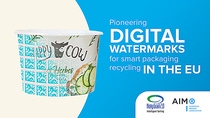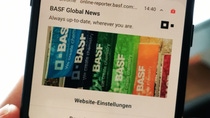Media
BASF joins Digital Watermark Initiative “HolyGrail 2.0” for smart packaging recycling
- Packaging industry aims to develop digital watermarking technology
- More than 120 companies and organizations join forces to assess the contribution of a pioneering digital watermark technology to better high-quality recycling
- Better sorting of post-consumer waste yields higher quality of recyclates and contributes to a circular plastic economy
BASF has joined “HolyGrail 2.0 – Digital watermarks for accurate sorting and high-quality recycling” as a member. The initiative aims to increase plastic recycling rates by adding imperceptible digital watermarks to product packaging.
Under the auspices of AIM, the European Brands Association, BASF and more than 120 companies and organizations from the packaging value chain have joined forces in the initiative to prove the viability of digital watermarking technologies for accurate sorting and the business case at large scale.
“The plastics used for packaging are extremely valuable materials to protect goods and reduce food waste. When plastics are sorted properly, we can offer a suitable additive package to return them to high-performance applications. Thus, we are excited to support HolyGrail 2.0 in their search for optimized and circular plastic packaging,” said Dr. Achim Sties, Senior Vice President, Performance Chemicals Europe, BASF.
Ineffective sorting is one of the fundamental barriers to wider recycling of lightweight packaging waste and thus in achieving a circular economy for packaging. The better the sorting and identification of packaging, the more efficient the mechanical recycling process and the better the quality of recyclates.
The discovery of digital watermarking was made under the New Plastics Economy program of the Ellen MacArthur Foundation, which investigated different innovations to improve post-consumer recycling. Digital watermarks were found to be the most promising technology. The “HolyGrail 2.0” initiative will include the launch of an industrial pilot to prove the viability of digital watermark technologies for more accurate sorting of packaging and higher-quality recycling, as well as the business case at large scale.
Digital watermarks are imperceptible codes, the size of a postage stamp, covering the surface of a consumer goods packaging. They can carry a wide range of attributes such as manufacturer, Stock Keeping Unit (SKU), type of plastics used and composition for multilayer objects or food versus non-food usage.
More information on the digital watermarks initiative – HolyGrail 2.0 is available here.
All information about the Circular Economy program of BASF can be found here.
Receive up-to-date news releases from BASF via push notification on your smartphone. Register for our news service at basf.com/pushnews.
About BASF
At BASF, we create chemistry for a sustainable future. We combine economic success with environmental protection and social responsibility. More than 110,000 employees in the BASF Group contribute to the success of our customers in nearly all sectors and almost every country in the world. Our portfolio is organized into six segments: Chemicals, Materials, Industrial Solutions, Surface Technologies, Nutrition & Care and Agricultural Solutions. BASF generated sales of €59 billion in 2020. BASF shares are traded on the stock exchange in Frankfurt (BAS) and as American Depositary Receipts (BASFY) in the U.S. Further information at www.basf.com.
P-21-205


